序章
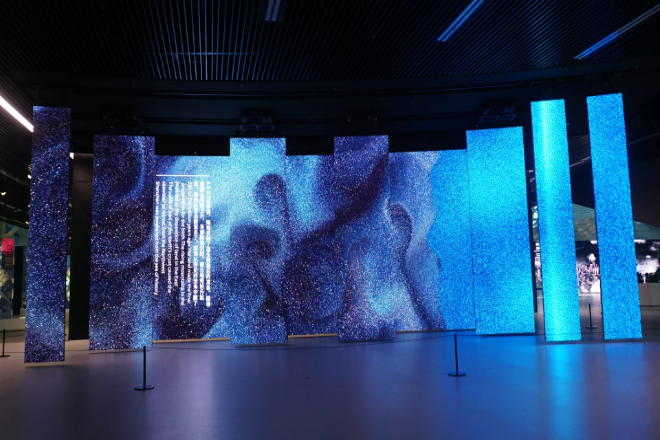
Have you noticed that art exhibitions are becoming more and more interesting? Walking into it is like entering a fantasy world, with gorgeous pictures and wonderful sounds everywhere.
Behind this, there is actually a “big contributor” – the LED display. Today, let’s talk about how this magical thing makes art exhibitions so immersive.
目次
1. Why do art exhibitions like immersion now?
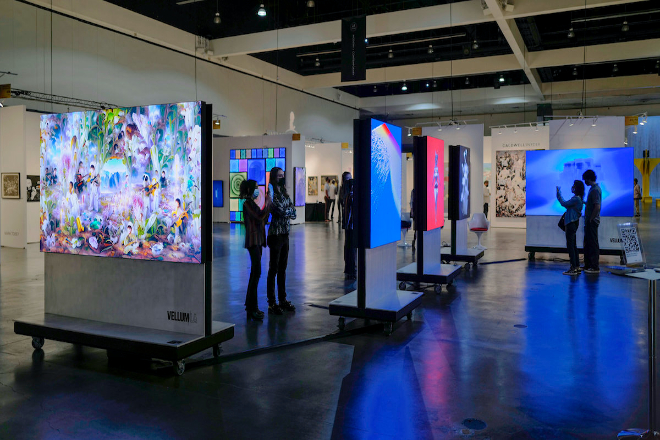
Have you noticed that going to art 展示会 now feels more and more like entering a fantasy world? Why is this immersive art exhibition so popular now? There are several reasons for this. Let’s talk about it together.
Today’s immersive art exhibitions are actually the perfect combination of technology and art.
Imagine that you walk into an exhibition hall surrounded by colorful pictures, your feet are on a moving floor, and your ears are filled with wonderful music.
Isn’t this feeling particularly cool? All this is inseparable from the help of high technology. For example, with virtual reality (VR) technology, you can put on glasses and instantly travel to another world.
With augmented reality (AR) technology, you can scan with your mobile phone, and the characters on the screen will come alive.
These technologies make artworks no longer just paintings hanging on the wall but become “living things” that can be interacted with and experienced.
In traditional art exhibitions, the audience is like watching a movie, just watching from a distance, and can’t do anything. But immersive exhibitions are different.
The audience can move their hands and feet and even “talk” to the artwork. For example, in some exhibitions, if you wave your hand, the picture will move; if you walk over, the sound will change.
This interactivity makes the audience no longer a bystander but truly integrated into the artwork, feeling that they are also part of the art. Isn’t this feeling particularly exciting?
Nowadays, people, especially young people, are increasingly pursuing experience. Going to a place is not just about seeing the scenery but also about feeling the atmosphere there. The same is true for art exhibitions.
Audiences are no longer satisfied with just looking at paintings and sculptures. What they want is a full range of sensory experiences. Immersive exhibitions meet this demand.
Through the combination of various elements such as sound, light, and electricity, audiences can hear, see, and even touch the artworks. This full range of experiences makes people feel particularly fresh.
Another benefit of immersive exhibitions is that they are particularly suitable for taking photos and checking in. Now, when people go to a place, their first reaction is to take photos and post them on WeChat Moments.
The scenes of immersive exhibitions are particularly beautiful and particularly suitable for taking photos. When the audience takes photos inside and posts them on social media, they will attract more friends to want to see them.
In this way, the popularity of the exhibition will increase, and more people will come to visit. This social attribute is also an important reason why immersive exhibitions are popular.
For the organizers of the exhibition, immersive exhibitions not only attract audiences but also make more money.
In addition to ticket revenue, they can also increase revenue by selling cultural and creative products, organizing parent-child workshops, and even engaging in immersive script killing.
For example, some exhibitions sell peripheral products, such as T-shirts and cups printed with exhibition patterns, which are very popular.
These extra incomes give the organizers more motivation to hold immersive exhibitions.
Another particularly interesting thing about immersive exhibitions is that they blur the boundaries between reality and virtuality.
In the exhibition, you may feel that you have entered a completely different world, which is both real and illusory.
For example, some exhibitions use projection technology to make you feel like you are swimming in the underwater world or walking under the stars.
This experience makes people feel particularly magical and also makes the audience’s understanding of art more profound.
The pace of life now is very fast, and everyone’s time is precious. Immersive exhibitions just adapt to this fast-paced life.
The audience can quickly feel the charm of art through interaction and experience in a short time.
For example, some exhibitions have interactive sessions, and the audience only needs a few minutes to experience a complete art scene.
This fast experience method is particularly suitable for the pace of modern people’s lives.
2. The role of LED display screens in immersive art exhibitions
In immersive art exhibitions, LED display screens are like a magical box that can take the audience to a whole new world. It is not only a tool for displaying pictures but also the soul of the entire exhibition.
Next, let’s talk about the important role of LED display screens in immersive art exhibitions.
1). Create an immersive visual experience
Imagine that you walk into an exhibition surrounded by LED screens; the pictures move, and the sound surrounds you. Isn’t this feeling particularly shocking?
This is the power of LED display screens in creating an immersive visual experience. These screens can not only display super beautiful pictures but also create a special atmosphere through the combination of lights, music and colors.
For example, if the theme of the exhibition is “Underwater World”, the LED screen can turn the entire space into a blue ocean, and fish swim around you, making you feel like you are really diving under the sea.
さらに、高い 輝度 and high contrast of the LED display screen allow the picture to be clearly presented under any lighting conditions, and the wide color gamut can show colorful visual effects, bringing a strong visual impact to the audience.
2). Enhanced interactivity
In the immersive exhibition of LED display screens, the audience is no longer a bystander but a participant who can “talk” with the works.
For example, you walk to a screen and wave your hand gently, and the flowers in the picture will bloom; you approach a device, and it will start to glow and make sounds.
This kind of interaction is not only fun but also allows you to understand the work more deeply. Moreover, the technology is getting better and better, and sensors and gesture recognition technology make the interaction more natural.
For example, in some exhibitions, the audience can control the changes in the picture just by moving their fingers, or the audience can stand in front of the screen, and the screen can automatically recognize your movements and respond accordingly.
This kind of interaction is like playing a game, which makes the audience completely immersed in it and feels very cool.
3). Guide emotional resonance
Art exhibitions are not only visual enjoyment but also emotional touch. LED display screens make the emotional expression of artworks more vivid through dynamic pictures and light and shadow effects.
For example, in a work showing the starry sky, through the dynamic display of the LED screen, the stars are twinkling, the Milky Way is flowing, and accompanied by soothing music, the audience will feel a sense of tranquility and mystery.
A work depicting war, through strong contrast of light and shadow and shocking sound effects, allows the audience to feel the cruelty and tragedy of war. The exhibition design will also guide the audience’s emotional experience.
For example, in an exhibition expressing love and peace, soft lighting, warm pictures and soothing music cooperate with each other, allowing the audience to naturally resonate emotionally during the visit as if they have become part of the work.
4). Provide multi-sensory stimulation
In the immersive exhibition of LED display screens, the audience can not only see with their eyes but also hear with their ears, touch with their hands, and even feel with their bodies.
This multi-sensory synergy makes the audience’s experience richer. For example, in some exhibitions, the LED screen and the sound system cooperate, and the audience can not only see the picture but also hear the matching music and sound effects.
This audio-visual combination feels particularly good. There are also some interactive devices. When the audience touches the screen with their hands, they can feel a slight vibration.
This tactile feedback makes the interaction more real. The application of multimedia technology makes this multi-sensory stimulation reach its extreme.
For example, through virtual reality (VR) technology, the audience can enter a virtual art world and interact more deeply with the works; through projection mapping technology, the audience’s body movements can become part of the picture, creating a unique visual effect.
This all-around sensory stimulation makes the audience feel as if they are in an art space where reality and virtuality are intertwined, and they feel the charm of art.
5). Flexible space layout
Another great advantage of LED display is its flexibility. It can be designed in various shapes and sizes and installed in any position.
For example, it can be a large screen on the wall, an interactive device on the ground, or even a dome screen on the ceiling.
This flexibility makes the spatial layout of the exhibition more diverse. According to the theme and content of the exhibition, the position of the screen can be cleverly arranged to guide the audience’s visiting route.
For example, some exhibitions are designed to be surrounded by the audience standing in the middle, and the pictures around them constantly change. This all-round visual experience makes people feel particularly addicted.
6). Real-time content update
The content of the LED display can be updated in real-time, which enables the exhibition to be adjusted according to different times and themes.
For example, the exhibition can update the content on the screen at any time according to seasonal changes, festival activities or audience feedback. This flexibility not only keeps the exhibition fresh but also better attracts the audience.
Moreover, through computer control, the content update is very convenient, and the staff can easily adjust the pictures and videos in the background to ensure that the exhibition is always in the best condition.
In general, the LED display plays a huge role in immersive art exhibitions. It not only provides a shocking visual experience, but also enhances interactivity, guides emotional resonance, provides multi-sensory stimulation, and can flexibly adjust the spatial layout and content as needed.
This all-round experience makes the audience feel as if they are in an art world where the real and the virtual are intertwined, and feel the charm of art.
3. Strategies for LED display screens to enhance immersion
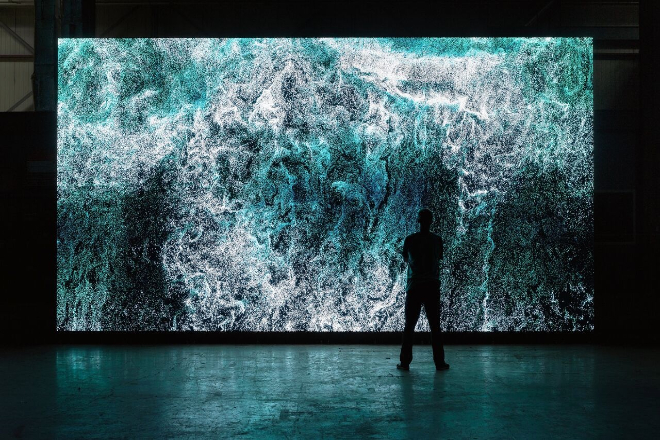
1). Space layout and scene design
To immerse the audience completely, the exhibition space must first be designed to be “magical.” This requires LED display screens to build an immersive space.
For example, the LED screen is made into a surround type, and the audience stands in the middle, surrounded by pictures.
This 360-degree visual impact without dead angles can instantly bring people into another world. Or the screen is installed on the ceiling, and the starry sky is visible when you look up, and the underwater world is visible when you look down.
This all-round sense of surroundings makes people feel particularly real. In addition, the audience’s tour route must be reasonably planned so that people will not get dizzy.
For example, a one-way tour route is designed, and the audience walks and looks all the way, and there are new surprises waiting at every corner. This guided layout can make the audience’s experience more coherent and not messy.
2). Content creation and presentation
Having good equipment alone is not enough without good content. This requires cooperation with artists to create content specifically for LED display screens.
Artists can design super cool pictures and animations based on the characteristics of the screen.
For example, using dynamic images and special effects to make the picture move, flowing like water or burning like flames, this kind of visual impact is particularly strong. In addition, the content must be customized according to the theme of the exhibition.
For example, if the theme of the exhibition is “Future City,” the picture must have elements such as high-rise buildings, flying cars, and robots so that the audience will feel that they have entered the future world as soon as they see it.
In short, the content must be perfectly combined with the screen to achieve the greatest effect.
3). Interactive experience design
Nowadays, people like to participate. Therefore, some interactive devices based on LED display screens must be developed.
For example, when the audience stands in front of the screen and waves their hands, the things in the picture will move, or when the audience approaches the screen, the screen will automatically sense and display some hidden information.
These interactive devices can make the audience feel that they have a real “connection” with the artwork. Moreover, there are many advanced technologies that can help, such as sensors and gesture recognition technology.
These technologies can accurately capture the audience’s movements and then make the screen respond accordingly. For example, when the audience makes a gesture, the picture on the screen will switch.
When the audience approaches the screen, the screen will be enlarged. This interactive experience not only increases the fun of the exhibition but also allows the audience to understand the artwork more deeply.
4). Multimedia integration and synergy
Vision alone is not enough, and other senses must also be involved. This requires the combination of multimedia elements such as audio and lighting.
For example, the picture shows a forest, accompanied by audio of birds and, wind and soft lighting.
This multi-sensory synergy can make the audience’s experience more real. In addition, the synchronous control technology of the LED display is also critical.
For example, when the picture switches, the audio and lighting also switch with it. This coordinated playback can make the audience’s experience more coherent.
For example, when the picture switches from day to night, the lighting also changes from bright to dim, and the audio changes from bird calls to insect sounds.
This all-round change can make the audience completely immersed in it and feel that they have really entered another world.
4. Application cases of LED displays in art exhibitions
1). Internationally renowned exhibition cases
1.1). teamlab
Teamlab is a team famous for its digital art. Their exhibitions often create amazing immersive experiences through LED displays.
In the Teamlab exhibition, LED screens are cleverly arranged in every corner, creating an art space full of fantasy through dynamic images and light and shadow effects.
For example, in their “Forest” series of exhibitions, the audience seems to be in a breathing forest, with trees, flowers, water and other elements dynamically presented on the LED screen.
Every movement of the audience will trigger changes in the picture, and this interactivity allows the audience to be completely immersed in it.
1.2). Digital Dunhuang
The Digital Dunhuang project presents Dunhuang’s murals and culture to the audience in a new form through LED screens and projection technology.
In the “Digital Dunhuang” exhibition, LED screens are used to display high-precision restored images of murals. The audience can touch the screen to deeply understand the details of the murals and the historical stories behind them.
In addition, the exhibition also uses the dynamic imaging technology of the LED screen to make the characters and scenes in the murals “alive,” as if the audience has traveled through time and space back to ancient Dunhuang.
In these exhibitions, the LED screen greatly enhances the immersion of the exhibition through high resolution, high contrast and dynamic imaging technology, making the audience feel as if they are in the works of art.
2). Display of different art forms
2.1). Paintings
For paintings, LED screens can display every detail of the works with high resolution and high color reproduction. For example, in the Beeple exhibition at Nanjing Deji Art
Museum, a giant LED screen with a height of 5 meters and a length of 20 meters was used to create an immersive viewing experience in the entire venue through “large screen surround combined with the multi-angle reflection of the mirror.”
This display method not only allows the audience to clearly see every detail of the painting but also makes the picture “dynamic” through dynamic imaging technology, enhancing the visual impact.
2.2). Sculptures
LED screens can provide dynamic backgrounds and light and shadow effects for sculptures, enhancing the three-dimensional sense and sense of space of the works.
For example, in some modern sculpture exhibitions, LED screens are arranged around the sculptures.
Through the changes in light and shadow and dynamic images, the sculptures seem to be displayed in different environments, which increases the layering and depth of the works.
2.3). Installation art
Installation art usually requires the participation and interaction of the audience, and LED screens can adapt well to this demand.
For example, in the installation art exhibition of teamlab, the audience can interact with the content on the LED screen by touching, moving, etc., and the pictures on the screen will respond accordingly to the audience’s actions, allowing the audience to become part of the artwork.
LED display screens can adapt to the display needs of different art forms through their flexibility and diversity, bringing a new art experience to the audience.
5. Innovative application of LED display screens in art exhibitions
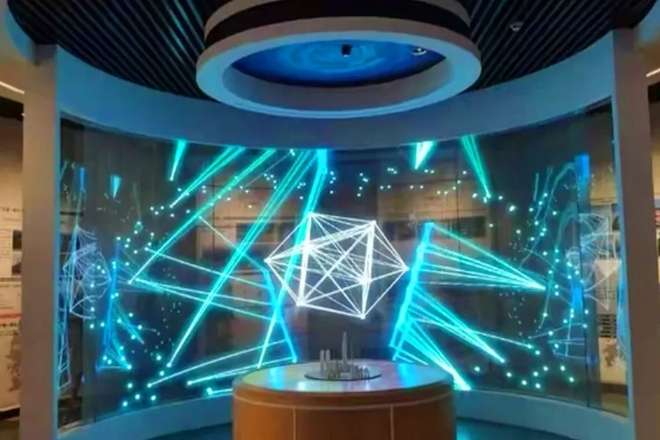
1). 透明LEDディスプレイスクリーン
1.1) 利点:
The transparent LED display screen is like a magical “magic glass”. It allows you to clearly see what is behind the screen, while also displaying a variety of beautiful pictures. This combination of virtual and real feels particularly cool.
Moreover, this screen is particularly thin and light, like a piece of paper, which is easy to install and move around.
Most importantly, it is energy-saving and does not consume as much power as traditional screens. It is both environmentally friendly and cost-effective to use.
1.2). Application:
In art exhibitions, transparent LED display screens can play many new tricks.
For example, it can be placed next to cultural relics, displaying cultural relics while playing the stories behind the cultural relics, allowing the audience to understand history while looking at the real objects.
It can also simulate scenes such as the starry sky and the seabed, and the audience will feel like they have walked into a fantasy world.
If it is made into a display cabinet, it can not only protect the exhibits but also display more information, killing two birds with one stone.
In art exhibitions, it can also become a dynamic scroll, telling ancient stories with light and shadow, and giving traditional art new vitality.

2.1) 利点:
Flexible LED display is like a piece of paper that can be bent at will, and you can bend it however you want. It can easily fit various strange shapes and perfectly blend with art installations to make super cool shapes.
Moreover, it is light and thin, easy to carry and easy to install. Most importantly, the picture it displays is colorful, high in contrast, and looks particularly comfortable.
2.2). Application:
In art exhibitions, the combination of flexible LED displays and art installations is a perfect match. It can add dynamic light and shadow effects to art installations, making the works look more vital.
For example, a sculpture can be paired with a curved, flexible screen, and the light and shadow on the screen will flow with the shape of the sculpture, which is particularly impressive.
If the flexible screen is surrounded by a circle, it can also create an immersive space. When the audience walks in, it feels like they are surrounded by art, and the experience is super strong.
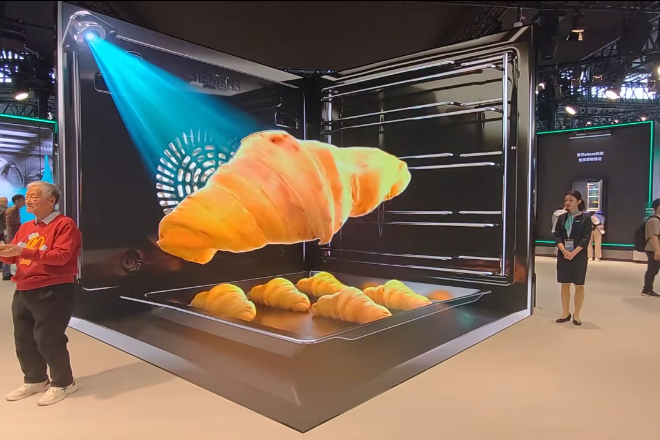
3). 3D LEDディスプレイ
3.1) 利点:
The principle of 3D LED display is a bit like the stereoscopic book we played when we were young. Through special display technology, the picture looks like it “jumps” out of the screen.
Especially with the naked eye 3D technology, you can see the stereoscopic effect without wearing glasses, which is very convenient and will not make people feel dizzy.
3.2). Application:
In immersive art exhibitions, 3D LED display is simply the “atmosphere.” It allows the audience to see lifelike pictures, such as the animals in a painting seem to run out of the picture, which is very realistic.
This three-dimensional effect can make the artwork more appealing and engage the audience.
Moreover, it breaks the limitations of traditional flat displays and gives art exhibitions a new way of playing. The audience can not only see but also feel that art is around them.

4). Interactive LED display
4.1). Advantages:
Interactive LED display is like a screen that can “chat” with you. It can “sense” your movements through sensors, or let you touch the screen directly with your hands to interact with it.
For example, when you get close to the screen, it will display different pictures; when you touch it with your hands, it can also react, which is very fun.
4.2). Application:
In art exhibitions, interactive LED displays can greatly increase the audience’s sense of participation.
For example, on a dance floor, when the audience dances, the screen will change different light and shadow effects according to the dance steps, which is very cool.
Moreover, it can also provide personalized display content according to the audience’s interests.
The audience can see what they want to see and play however they want, making art exhibitions more interesting and attractive.
6. Conclusion
In short, LED display is simply a “magic box” in art exhibitions, making traditional art cool and fun.
It not only makes the audience feel good, but also allows the audience to participate in it and feel the charm of art.
In the future, as technology becomes more and more powerful, LED display will definitely bring more surprises, let us look forward to it together!
最後に、LEDディスプレイについてもっと知りたい方は、 ご連絡ください。
